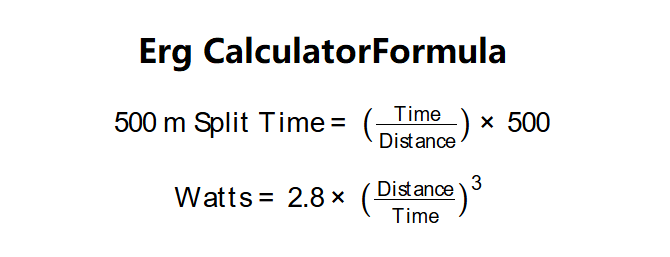1. What is an ERG Calculator?
Definition: This calculator computes the 500 m split time and power output for a given distance and time on an ergometer, allowing users to select input units for distance (meters, feet, yards) and time (seconds, minutes), and output units for split time (seconds, minutes) and power (Watts, Kilowatts, Joules/second, Calories/second).
Purpose: It provides flexibility in unit selection for both inputs and outputs, making it easier to align with user preferences or equipment settings.
2. How Does the Calculator Work?
The calculator performs calculations in base units (meters, seconds, Watts) and converts results to the selected output units:
500 m Split Time:
\( \text{500 m Split Time} = \left( \frac{\text{Time}}{\text{Distance}} \right) \times 500 \)
Converted to minutes if selected (1 min = 60 sec).
Power Output (Watts):
\( \text{Watts} = 2.8 \times \left( \frac{\text{Distance}}{\text{Time}} \right)^3 \)
Converted to the selected unit:
- 1 W = 1 J/s
- 1 W = 0.239 cal/s
- 1 kW = 1000 W
Steps:
- Enter Distance and Time with their respective units.
- Convert inputs to meters and seconds.
- Compute 500 m Split Time and Power in base units.
- Convert results to the selected output units using dropdowns after the result fields.
- Display the formatted Split Time (in minutes and seconds) for readability.
3. Importance of ERG Calculations
These calculations are crucial for:
- Customizable Outputs: Users can view results in their preferred units without re-entering data.
- Training Flexibility: Aligns with different ergometer displays or training logs.
- Performance Analysis: Split time and power metrics help evaluate rowing efficiency.
4. Using the Calculator
Example 1: A rower completes 2000 m in 8 minutes, views split time in minutes and power in cal/s:
- Distance: 2000 m
- Time: 8 min = 480 sec
- 500 m Split Time: \( \left( \frac{480}{2000} \right) \times 500 = 120 \, \text{seconds} \)
- Split Time in minutes: \( 120 / 60 = 2.00 \, \text{minutes} \)
- Formatted Split: 2 minutes and 0 seconds
- Watts: Pace = \( \frac{2000}{480} \approx 4.167 \, \text{m/s} \), Watts = \( 2.8 \times (4.167)^3 \approx 202.6 \)
- Power in cal/s: \( 202.6 \times 0.239 \approx 48.42 \, \text{cal/s} \)
- Result: 500 m Split = 2.00 minutes, Power = 48.42 cal/s
Example 2: A rower completes 3000 ft in 600 seconds, views split time in seconds and power in kW:
- Distance: 3000 ft = \( 3000 \times 0.3048 = 914.4 \, \text{m} \)
- Time: 600 sec
- 500 m Split Time: \( \left( \frac{600}{914.4} \right) \times 500 \approx 328 \, \text{seconds} \)
- Formatted Split: 5 minutes and 28 seconds
- Watts: Pace = \( \frac{914.4}{600} \approx 1.524 \, \text{m/s} \), Watts = \( 2.8 \times (1.524)^3 \approx 9.9 \)
- Power in kW: \( 9.9 / 1000 = 0.01 \, \text{kW} \)
- Result: 500 m Split = 328 seconds, Power = 0.01 kW
5. Frequently Asked Questions (FAQ)
Q: How do I change the output units?
A: Use the dropdowns next to the 500 m Split Time and Power Output fields to select your preferred units, and the form will automatically update.
Q: Why is the formatted split time always in minutes and seconds?
A: This format provides a more intuitive understanding of the split time, regardless of the unit chosen for the numeric Split Time field.
Q: Are the calculations affected by changing output units?
A: No, the base calculations are done in seconds and Watts, and the output units only affect how the results are displayed.
 Home
Home
 Back
Back
